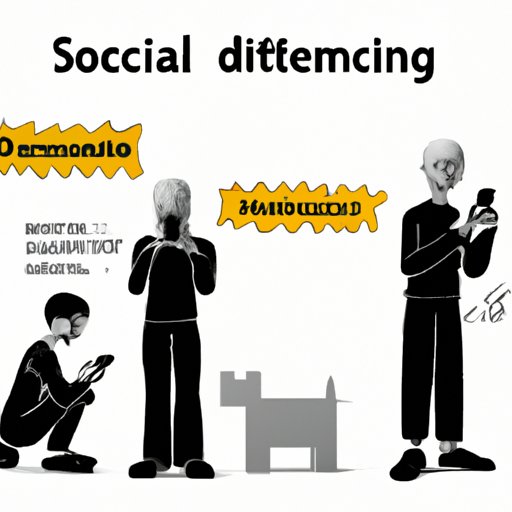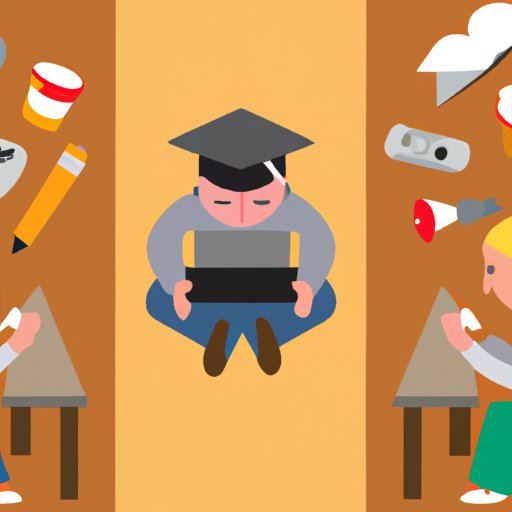Introduction
In our modern world, technology has become an integral part of daily life. As technology advances, it is becoming increasingly commonplace in educational settings. While technology can be a valuable tool in education, it can also cause problems if not used properly. This article will explore how technology negatively affects education, and provide strategies to help address these issues.
Increased Distractions: How Students are Easily Distracted by Technology in the Classroom
One of the most common issues caused by technology in the classroom is distraction. With the availability of smartphones, tablets, and other devices, students can easily get sidetracked from their studies. This can lead to decreased focus, lower grades, and disruptions in the classroom environment.
There are several types of distractions caused by technology. For example, students may spend too much time playing games or browsing the internet instead of paying attention to the lesson. They may also be distracted by notifications from social media, text messages, emails, or other apps. Additionally, some students may be tempted to take pictures or videos of the teacher or other students.
In order to reduce distractions caused by technology in the classroom, teachers should set clear rules about when and how technology can be used. For example, they can ask students to turn off their phones or put them away during class. They can also limit the amount of time students can spend on their devices. Additionally, teachers should encourage students to use technology responsibly, and model this behavior themselves.

Diminished Social Skills: The Impact of Technology on Communication and Interaction
Another issue caused by technology in education is diminished social skills. With the growing popularity of online communication, students are spending less time interacting with others face-to-face. This can lead to difficulty in forming meaningful relationships, as well as a lack of empathy and emotional intelligence.
There are several challenges to face-to-face interactions caused by technology. For example, students may be more comfortable communicating through text or email than speaking directly to someone. They may also be more likely to say things online that they would not say in person. Additionally, students may struggle to read body language or interpret tone in conversations, which can lead to misunderstandings.
In order to help students develop social skills, teachers should create opportunities for face-to-face interaction. For example, they can encourage students to work together in small groups or give presentations in front of the class. Teachers can also model good communication skills, such as active listening and being respectful of others’ opinions. Additionally, teachers can facilitate discussions about emotions and empathy, and discuss appropriate ways to express feelings.

Disrupted Learning: How Technology is Disrupting Traditional Education
Another problem caused by technology in education is disrupted learning. With the increasing availability of online courses, tutorials, and other resources, students can now access information more quickly and easily than ever before. However, this can also lead to a decrease in traditional learning methods, such as lectures and textbooks.
There are both advantages and disadvantages to technology in education. On one hand, it can make learning more efficient and accessible. On the other hand, it can lead to a lack of deep understanding and critical thinking. Additionally, technology can be expensive, and not all students have access to the same resources.
In order to balance technology and traditional education, teachers should find ways to integrate both into their classrooms. For example, they can use technology to supplement lectures and readings, rather than replacing them entirely. Additionally, teachers should ensure that all students have equal access to technology, and provide alternate learning materials for those who do not.
Unhealthy Habits: How Technology Usage Affects Student Health and Well-Being
Another issue caused by technology in education is unhealthy habits. With the rise of smartphones and other devices, students are spending more time than ever on their screens. This can lead to physical health issues, such as poor posture, headaches, and eyestrain. It can also lead to mental health issues, such as anxiety, depression, and sleep disturbances.
There are several potential health risks associated with excessive technology usage. For example, students may be at risk of developing carpal tunnel syndrome or other physical ailments due to prolonged typing or gaming. They may also be at risk of developing addiction or other psychological issues due to overuse of social media or video games.
In order to maintain a healthy balance with technology, teachers should encourage students to take regular breaks from their devices. They can also teach students about the importance of getting enough sleep and exercise, and discuss the potential risks associated with excessive technology usage. Additionally, teachers should model healthy technology habits, such as turning off devices during meals or taking time away from screens.

Academic Cheating: The Growing Problem of Cheating with Technology
Finally, another issue caused by technology in education is academic cheating. With the availability of online resources, students are increasingly turning to the internet for help with their homework and tests. This can lead to a decrease in academic integrity, as well as a lack of accountability for student work.
There are several common methods of cheating with technology. For example, students may look up answers online during tests, or copy and paste text from websites without citing the source. They may also collaborate on assignments using messaging apps or other forms of online communication.
In order to prevent cheating with technology, teachers should set clear expectations for student work. For example, they can require students to cite sources or submit original work. They can also use plagiarism detection software to check for copied material. Additionally, teachers should discuss the importance of academic integrity with their students, and explain the consequences of cheating.
Conclusion
In conclusion, technology can be a valuable tool in education, but it can also cause problems if not used properly. This article explored how technology negatively affects education, including increased distractions, diminished social skills, disrupted learning, unhealthy habits, and academic cheating. By understanding these issues and implementing strategies to address them, teachers can help ensure that technology is used in a positive and productive way.
(Note: Is this article not meeting your expectations? Do you have knowledge or insights to share? Unlock new opportunities and expand your reach by joining our authors team. Click Registration to join us and share your expertise with our readers.)
